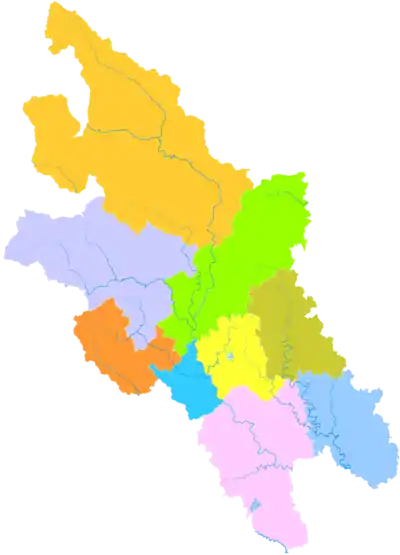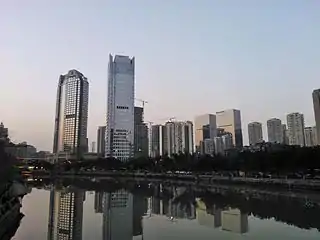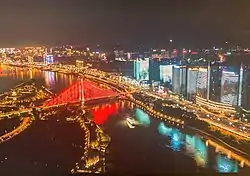Mianyang
绵阳市 | |
|---|---|
 Clockwise from top: The view of Mianyang City from Fule Park, Yuewang Mansion at night, Night scene along Fujiang River in Mianyang City, Ziyun Pavilion in Xishan Park of Mianyang | |
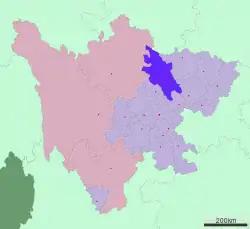 Location of Mianyang in Sichuan | |
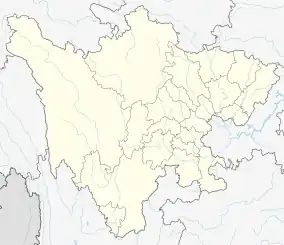 Mianyang Location of the city center in Sichuan 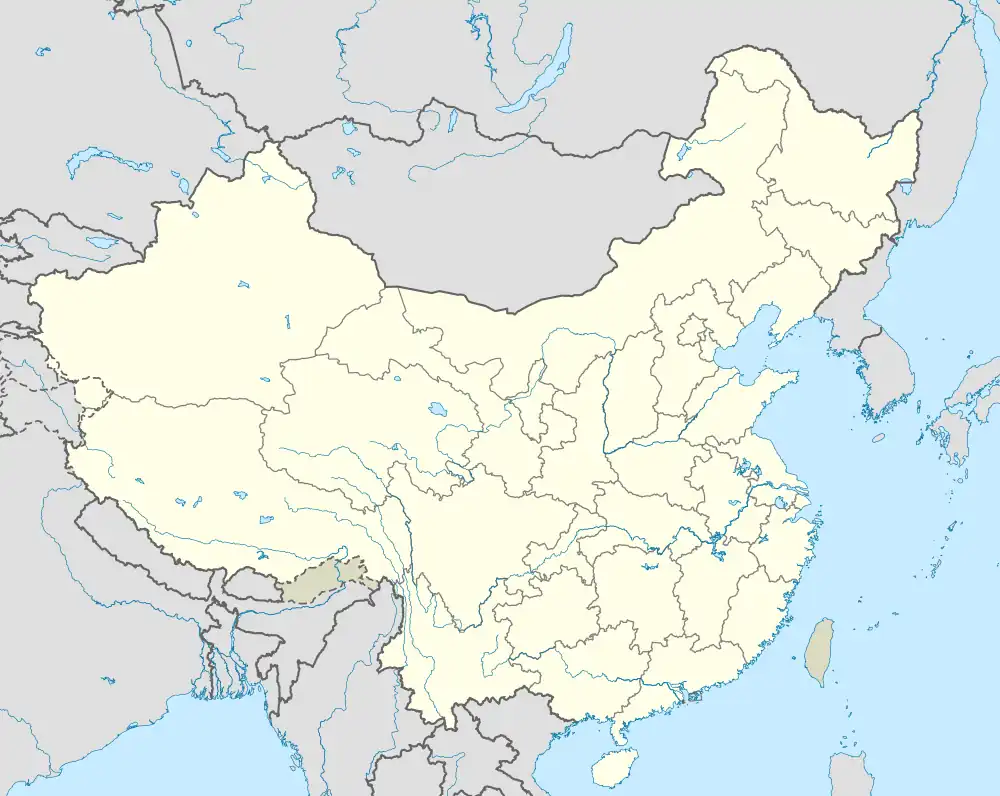 Mianyang Mianyang (China) | |
| Coordinates (Mianyang municipal government): 31°28′05″N 104°40′44″E / 31.468°N 104.679°E | |
| Country | People's Republic of China |
| Province | Sichuan |
| Municipal seat | Fucheng District |
| Government | |
| • CPC Party Chief | Peng Yuxing |
| • Mayor | Liu Chao |
| Area | |
| • Prefecture-level city | 20,267.46 km2 (7,825.31 sq mi) |
| • Urban | 2,755.4 km2 (1,063.9 sq mi) |
| • Metro | 2,755.4 km2 (1,063.9 sq mi) |
| Elevation | 473 m (1,552 ft) |
| Highest elevation | 5,588 m (18,333 ft) |
| Lowest elevation | 307 m (1,007 ft) |
| Population (2020 census)[1] | |
| • Prefecture-level city | 4,868,243 |
| • Density | 240/km2 (620/sq mi) |
| • Urban | 2,232,865 |
| • Urban density | 810/km2 (2,100/sq mi) |
| • Metro | 2,232,865 |
| • Metro density | 810/km2 (2,100/sq mi) |
| Time zone | UTC+8 (China Standard) |
| Postal code | 621000 |
| Area code | 0816 |
| ISO 3166 code | CN-SC-07 |
| License Plate Prefix | 川B |
| Tree | Cinnamomum camphora |
| Flower | Rosa chinensis |
| Website | www |
| Miányáng | |||||||||||||||
|---|---|---|---|---|---|---|---|---|---|---|---|---|---|---|---|
"Miányáng" in Chinese characters | |||||||||||||||
| Simplified Chinese | 绵阳 | ||||||||||||||
| Traditional Chinese | 綿陽 | ||||||||||||||
| Literal meaning | "South of Mian Mountain" | ||||||||||||||
| |||||||||||||||
Mianyang (simplified Chinese: 绵阳; traditional Chinese: 綿陽; pinyin: Miányáng; Wade–Giles: Mien2-yang2; formerly known as Mienchow, Chinese: 綿州; pinyin: Mianzhou; lit. 'Mian Prefecture') is the second largest prefecture-level city of Sichuan province in Southwestern China. Located in north-central Sichuan covering an area of 20,281 square kilometres (7,831 sq mi) consisting of Jiangyou, a county-level city, five counties, and three urban districts. Its total population was 4,868,243 people at the 2020 Chinese census, of whom 2,232,865 live in its built-up (or metro) area made of three urban districts.
History
Mianyang, which was known as Fuxian (Fu County) in ancient times, had advanced in agriculture during the Qin (221−206 BCE) and Han (206 BCE−220 CE) dynasties. It has a history of over 2,200 years since the Emperor Gaozu of Han established the first county in this area in 201 BCE. Due to its advantageous location, it had always been a town of great military importance and formed a natural defence for Chengdu.[2]
Mianyang is home to the CAEP and Science City, an immense Military Research Complex which was the site of the development of China's first nuclear bomb.
The city proper itself was only lightly damaged by the earthquake of 12 May 2008. However, Beichuan County, which is in the prefecture, was among the most severely hit of all disaster regions following the earthquake, including the Beichuan High School campus where more than 1,000 students lost their lives after two main buildings collapsed.[3] Around 80% of the county's buildings are said to have collapsed, including its main government building.[4] The casualty toll for the quake in Mianyang Prefecture as of 7 June 2008, was 21,963 people killed, 167,742 injured, and 8,744 people missing.[5][6]
Geography and climate
Mianyang is at the northwestern end of the Sichuan Basin, on the upper to middle reaches of the Fu River. Its administrative area ranges in latitude from 30° 42' to 33° 03' N and in longitude from 103° 45' to 105° 43' E. Bordering prefectures are Guangyuan to the northeast, Nanchong to the east, Suining to the south, Deyang to the southwest, and the Ngawa Tibetan and Qiang Autonomous Prefecture to the west. It also borders Gansu for a small section in the north.
Mianyang has a monsoon-influenced humid subtropical climate (Köppen Cwa) and is largely mild and humid, with four distinct seasons. Winter is short, mild, and foggy, though precipitation is low. January averages 5.3 °C (41.5 °F), and while frost may occur, snow is rare. Summers are long, hot, and humid, with highs often exceeding 30 °C (86 °F). The daily average in July, the warmest month, is 25.7 °C (78.3 °F). Rainfall is light in winter and can be heavy in summer, and more than 70% of the annual total occurs from May to September. The annual frost-free period across most of the prefecture lasts from 252 to 300 days, and there are only 1,100 hours of sunshine annually, which is not even 30% of the possible total.
| Climate data for Mianyang (1991–2020 normals, extremes 1971–2000) | |||||||||||||
|---|---|---|---|---|---|---|---|---|---|---|---|---|---|
| Month | Jan | Feb | Mar | Apr | May | Jun | Jul | Aug | Sep | Oct | Nov | Dec | Year |
| Record high °C (°F) | 19.0 (66.2) |
23.9 (75.0) |
32.1 (89.8) |
33.9 (93.0) |
35.9 (96.6) |
36.8 (98.2) |
38.9 (102.0) |
41.0 (105.8) |
36.6 (97.9) |
31.7 (89.1) |
25.0 (77.0) |
20.8 (69.4) |
41.0 (105.8) |
| Mean daily maximum °C (°F) | 9.6 (49.3) |
12.5 (54.5) |
17.4 (63.3) |
23.3 (73.9) |
27.1 (80.8) |
29.3 (84.7) |
30.9 (87.6) |
30.7 (87.3) |
26.1 (79.0) |
21.1 (70.0) |
16.2 (61.2) |
10.8 (51.4) |
21.2 (70.3) |
| Daily mean °C (°F) | 6.0 (42.8) |
8.6 (47.5) |
12.9 (55.2) |
18.2 (64.8) |
22.1 (71.8) |
24.7 (76.5) |
26.5 (79.7) |
26.1 (79.0) |
22.1 (71.8) |
17.5 (63.5) |
12.6 (54.7) |
7.4 (45.3) |
17.1 (62.7) |
| Mean daily minimum °C (°F) | 3.3 (37.9) |
5.7 (42.3) |
9.6 (49.3) |
14.3 (57.7) |
18.2 (64.8) |
21.3 (70.3) |
23.2 (73.8) |
22.8 (73.0) |
19.5 (67.1) |
15.1 (59.2) |
10.1 (50.2) |
4.8 (40.6) |
14.0 (57.2) |
| Record low °C (°F) | −5.3 (22.5) |
−4.3 (24.3) |
−3.4 (25.9) |
0.3 (32.5) |
7.2 (45.0) |
14.2 (57.6) |
17.3 (63.1) |
15.8 (60.4) |
13.3 (55.9) |
3.8 (38.8) |
−2.1 (28.2) |
−7.3 (18.9) |
−7.3 (18.9) |
| Average precipitation mm (inches) | 8.4 (0.33) |
9.4 (0.37) |
20.2 (0.80) |
45.6 (1.80) |
77.0 (3.03) |
98.5 (3.88) |
213.8 (8.42) |
175.2 (6.90) |
130.7 (5.15) |
40.5 (1.59) |
12.9 (0.51) |
5.5 (0.22) |
837.7 (33) |
| Average precipitation days (≥ 0.1 mm) | 5.7 | 6.1 | 8.8 | 10.9 | 12.6 | 13.5 | 14.3 | 13.1 | 14.5 | 12.5 | 5.7 | 4.2 | 121.9 |
| Average snowy days | 1.4 | 0.6 | 0.1 | 0 | 0 | 0 | 0 | 0 | 0 | 0 | 0.1 | 0.2 | 2.4 |
| Average relative humidity (%) | 74 | 71 | 68 | 67 | 65 | 72 | 77 | 76 | 79 | 78 | 77 | 75 | 73 |
| Mean monthly sunshine hours | 60.1 | 62.7 | 91.1 | 121.5 | 129.0 | 113.5 | 130.5 | 145.4 | 76.2 | 63.6 | 61.2 | 57.5 | 1,112.3 |
| Percent possible sunshine | 19 | 20 | 24 | 31 | 30 | 27 | 31 | 36 | 21 | 18 | 20 | 18 | 25 |
| Source 1: China Meteorological Administration[7][8] | |||||||||||||
| Source 2: Weather China[9] | |||||||||||||
Transport
The city has highway and railway connections to several major cities and is on the road from Xi'an to the provincial capital of Chengdu as well as the Baocheng Railway running from Baoji in Shaanxi province to Chengdu.
Mianyang Nanjiao Airport, which is the second largest airport in Sichuan province, has direct flights to Beijing, Shanghai, Guangzhou, Xi'an, Shenzhen, Kunming, Hangzhou, and so on.
G5 Beijing–Kunming Expressway and G93 Chengyu Ring Expressway.
Economy
Mianyang is one of China's major centres for the electronics industry. It has many well-known research institutions, such as the China Academy of Engineering Physics and China Aerodynamics Research and Development Center. Many large-scale enterprises, such as Changhong Electronics Group Corporation, Sichuan DND Pharmaceutical Co., Ltd., Jiuzhou Electronics Group, Shuangma Cement Group, and Changcheng Special Steel Company also have their home in Mianyang.
Mianyang is an important national defence, scientific research, and production base, consisting of 18 institutes including the China Academy of Engineering Physics and the China Aerodynamics Research Institute. Moreover, it houses 50 large- and medium-size enterprises and six science colleges.
The provincial government will hand over greater administrative powers of economic management at the provincial-level authority to propel the development of Mianyang. The new economy management authority will pay close attention to the construction of the scientific city. The provincial committee party and government are presently drafting the "Opinions on Propelling China Scientific City Construction" report which is expected to come out soon.
Mianyang Hi-Tech Industrial Development Zone
Education
There are six universities and colleges in the city, and it is well-known as a science and technology centre.
The best known of these is Southwest University of Science and Technology, with a campus of 4000 mu (about 260 hectares (640 acres)). There is a wide-band multimedia campus network, which is connected to the Internet. The student dorm has access to telephone, Internet, and TV. There are over 900,000 copies of books and over 10,000 electronic books in the library. The studying and living facilities are all on the campus.
Others:
People
It is the hometown of the famous poet Li Bai, and boasts many historical relics of the Three Kingdoms period.
Li Shunxian was a poet of Persian descent flourished during the Former Shu period (907–925). She had two brothers, Li Xun, a poet and pharmacologist, author of Overseas Pharmacopoeia (海藥本草; Hǎiyào Běncǎo), and Li Xuan, also a pharmacologist and alchemist.[10] Their religious background has been suggested as Zoroastrian or Nestorian Christian by Li Guotao and Lo Hsiang-lin, respectively. In his "The Transmission of Foreign Medicine via the Silk Roads in Medieval China: A Case Study of Haiyao Bencao", Chen Ming states that he is "inclined to agree with Lo Hsiang-lin, and to conclude that Li Xun was probably a Nestorian who was influenced by Taoism". However, both suppositions lack solid evidence and remain to be proven.[11]
Li Bifeng is a democracy advocate and a house church Christian, founder of an organization of conscience-based care for conducting written reports on the living conditions of laid-off workers, women, and children. He was imprisoned several times by Chinese authorities.[12]
Wang Yi is a Calvinist pastor from Santai and founder of the house church Early Rain Covenant Church in Chengdu. In 2018, he was arrested on allegations of "inciting subversion of state power".[13]
Wang Jiujiang is a "mountains and water" landscape painter with Tibetan influence. He is classified as a member of national second-class artists.[14]
Chinese food blogger and internet celebrity Li Ziqi is from Pingwu County on Mianyang and shoots most of her video content in the surrounding countryside.
Several ethnic minorities live in Mianyang, such as the Tibetan and Qiang people.
Christianity
According to Asia Harvest, estimates from 2020 suggest that of the entire population (4,057,601) about 5.43% is Christian (220,501), including Christians within the "unofficial churches", i.e., the Catholic underground church and the Protestant house churches.[15]
Catholicism
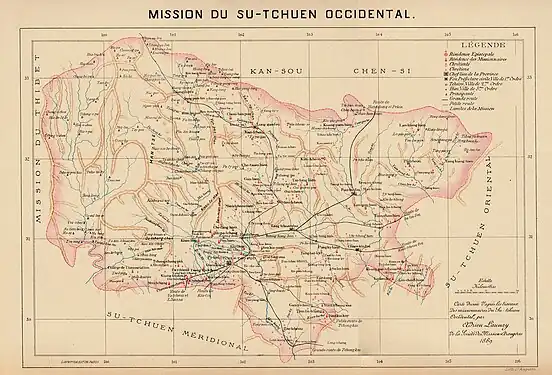
Christian presence in Sichuan (Szechwan) dates to the Tang dynasty (618–907) in the form of East Syriac Christianity.[16] In the case of Mianyang, the earliest evangelization to this region, according to Annals of Religion in Mianyang, was carried out in 1777 by Louis Gabriel Taurin Dufresse, a Catholic missionary and martyr saint of the Missions Étrangères de Paris (MEP). The first congregation was established in the 1820s in a small town named Bailin, now under the administration of Youxian District. A neo-Gothic church was subsequently built there and was expanded in 1913 by Alexandre Perrodin, which is known today as Bailin Catholic Church.[17] In 1883, Joseph-Marie-Félix Hatinguais took charge of the District of Lio-pin. He directed the mission work there until died of typhoid fever on 16 October 1886.[18] A purgatorial society existed in Beichuan before 1951.[19]
Our Lady of Lourdes Church is the only Catholic church building in Fucheng, the most populated district of Mianyang. Lucy Yi Zhenmei, a 19th-century local missionary from Mianyang, was martyred in Guizhou and canonized on 1 October 2000 by Pope John Paul II.
Mianyang region was historically part of the MEP's Western Szechwan Mission, and is now under the jurisdiction of the Bishop of Chengdu.[20] According to Asia Harvest, estimates from 2020 suggest that of the entire population (4,057,601) about 1.57% is Catholic (63,896), including underground church Catholics.[15]
Fourteen church buildings are included in a list in Annals of Religion in Mianyang,[21] namely:
- Bailin Catholic Church, Youxian District[22]
- Long'an Catholic Church, Pingwu County[23]
- Gucheng Catholic Church, Pingwu County[24]
- Tongchuan Catholic Church, Santai County[25]
- Xiushui Catholic Church, Anzhou District[26]
- Piankou Catholic Church, Beichuan Qiang Autonomous County[27]
- Xiaoba Catholic Church, Beichuan Qiang Autonomous County
- Shiban Catholic Church, Youxian District
- Huazhulin Catholic Church, Youxian District
- Xujia Catholic Church, Youxian District
- Tucheng Catholic Church, Pingwu County
- Daqiao Catholic Church, Pingwu County
- Zhongba Catholic Church, Jiangyou
- Xiping Catholic Church, Jiangyou
Protestantism
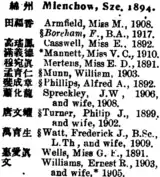
Protestantism was brought to Mianyang in 1894 by Anglican missions of the Church Missionary Society (CMS).[28] Alice Entwistle was largely responsible for the opening of this region for missionary work.[29] Or according to Annals of Religion in Mianyang, in 1885, a small mission church known as Gospel Church was already founded in Mianyang by Alfred Arthur Phillips and Gertrude Emma Wells of the Church Missionary Society.[30] However, Gospel Church, Jiangyou is traditionally regarded as the first CMS church in the Mianyang region.[31] In the late 1880s, two women representing the Church of England Zenana Missionary Society were working in this city.[32]
In 1908, William Munn established Hua Ying Primary School in Nanshan subdistrict (present-day Nanshan High School) and served as the first principal until 1916, when Frederick J. Watt assumed the position.[33] In 1918, Alfred Arthur Phillips established the first school for the dumb and the blind in Sichuan at Huang Family's Alley, Fucheng District.[34] Frederick Boreham, future Archdeacon of Cornwall, served as a missionary in Mianyang (Mien Yong) under the CMS from 1917 to 1924, and again from 1928 to 1934.[35]
After the split of the Diocese of Western China into Diocese of East Szechwan and Diocese of West Szechwan in 1936, Mianyang came under the authority of the latter which was supported by the CMS.[36]
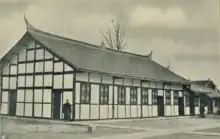
Santai County (formerly known as Tungchwan, pinyin: Tongchuan) was a centre of Quakerism, which was introduced in 1887,[37] and again in 1894 by Friends' Foreign Mission Association (FFMA).[38] Santai Mission became the largest mission branch of FFMA's Northern District. It was organized as Santai Monthly Meeting by Isaac Mason in 1900, under the administration of Szechwan Yearly Meeting.[39]
Since 1942, the Seventh-day Adventist Church had a small presence in Fenggu, a town under the administration of Fucheng. This denomination had a church built in July 1946, and made 99 converts before 1950[40] (see "Adventism in Sichuan"). True Jesus Church had a small presence in Jiangyou and Yanting since 1947.[41]
According to Asia Harvest, estimates from 2020 suggest that of the entire population (4,057,601) about 3.86% is Protestant (156,605; termed "Evangelicals"), including house church Protestants.[15]
Six church buildings are included in a list in Annals of Religion in Mianyang,[42] namely:
- Gospel Church at Fucheng District, Mianyang (prev. Anglicanism)[30]
- Gospel Church at Fuyi Town, Yanting County[43]
- Gospel Church at Tongchuan Town, Santai County (former Quaker meeting house)[44]
- Chengguan Gospel Church, Anzhou District (prev. Anglicanism)[45]
- Lingxing Protestant Church, Santai County
- Gospel Church, Jiangyou (prev. Anglicanism)
Food

·Mianyang Rice Noodles (绵阳米粉): One of the famous traditional dishes of the Han nationality in the Mianyang area with a history of more than 1,800 years. There are three flavours: red soup, clear soup, and clear red soup.
·Lengzhanzhan (冷沾沾): Lengzhanzhan originated in Mianyang Jiangyou. It is a snack that uses toothpicks to weave different dishes of meat and vegetables together and then dip different oil dishes.
· Mianyang rusty pancake/Guokui (绵阳脆皮锅盔): In the middle of the rusty pancake there is a dragon's eye like head of the pot kui, just pull out the eye and you can lift out the whole pot kui and it won't break at all.[46]
·Zitong shortcake (梓潼酥饼): Zitong shortcake is a traditional famous food of Han nationality. It is made of wheat flour, lard, white sugar, sesame and other raw materials by traditional handicraft.[46]
Subdivisions
| Map | |||||||||||
|---|---|---|---|---|---|---|---|---|---|---|---|
| # | Name | Hanzi | Hanyu Pinyin | Population (2010) |
Area (km²) | Density (/km²) | |||||
| 1 | Fucheng District | 涪城区 | Fúchéng Qū | 866,727 | 597,7 | 1,450 | |||||
| 2 | Youxian District | 游仙区 | Yóuxiān Qū | 488,604 | 973 | 502 | |||||
| 6 | Anzhou District | 安州区 | Ānzhōu Qū | 366,802 | 1,189 | 308 | |||||
| 3 | Jiangyou City | 江油市 | Jiāngyóu Shì | 762,142 | 2,720 | 280 | |||||
| 4 | Santai County | 三台县 | Sāntái Xiàn | 1,042,064 | 2,661 | 392 | |||||
| 5 | Yanting County | 盐亭县 | Yántíng Xiàn | 417,221 | 1,645 | 253 | |||||
| 7 | Zitong County | 梓潼县 | Zǐtóng Xiàn | 302,246 | 1,438 | 210 | |||||
| 8 | Pingwu County | 平武县 | Píngwǔ Xiàn | 170,959 | 5,974 | 29 | |||||
| 9 | Beichuan Qiang Autonomous County | 北川羌族 自治县 |
Běichuān Qiāngzú Zìzhìxiàn |
197,108 | 2,869 | 69 | |||||
References
- ↑ "China: Sìchuān (Prefectures, Cities, Districts and Counties) - Population Statistics, Charts and Map".
- ↑ "Mianyang Travel Guide".
- ↑ 四川北川中学震灾纪实 [Eye witnesses of the earthquake disaster in Beichuan Middle School, Sichuan] (in Simplified Chinese). bczx.changhong.com. Archived from the original on 2008-09-08. Retrieved 2008-10-01.
- ↑ "Death toll in China earthquake rises to 7,600". chicagotribune.com. Archived from the original on 16 May 2008. Retrieved 4 April 2018.
- ↑ 伤亡汇总_四川汶川强烈地震_新闻中心_新浪网 (in Chinese). Sina.com. 2008-05-28. Retrieved 2008-05-28.
- ↑ 21,963 deaths in Mianyang as of June 7, 18:00 CST,绵阳市抗震救灾情况通报 (in Chinese). Official website of Mianyang Government. 2008-06-08. Archived from the original on 2008-06-13. Retrieved 2008-06-08.
- ↑ 中国气象数据网 – WeatherBk Data (in Simplified Chinese). China Meteorological Administration. Retrieved 17 September 2023.
- ↑ 中国气象数据网 (in Simplified Chinese). China Meteorological Administration. Retrieved 17 September 2023.
- ↑ 绵阳 - 气象数据 -中国天气网 (in Simplified Chinese). Weather China. Retrieved 21 November 2022.
- ↑ Han, Xiang (10 March 2017). "唐朝境内的波斯人及其活动" [Persians and Their Activities in the Tang Empire]. ylyjzx.swu.edu.cn (in Simplified Chinese). Retrieved 1 December 2023.
- ↑ Chen, Ming (June 2007). "The Transmission of Foreign Medicine via the Silk Roads in Medieval China: A Case Study of Haiyao Bencao". Asian Medicine. 3 (2): 250–251. doi:10.1163/157342008X307866. Retrieved 1 December 2023.
- ↑ Zhang, Ping (16 September 2018). "'残酷的童话':狱中作家李必丰小说在柏林获赞" ["A Cruel Fairy Tale": Li Bifeng's Novel Well Received in Berlin]. dw.com (in Simplified Chinese). Retrieved 3 December 2023.
- ↑ Berlinger, Joshua (17 December 2018). "Detention of 100 Christians raises concerns about religious crackdown in China". edition.cnn.com. Retrieved 3 December 2023.
- ↑ Zhang, Dengjun (2 June 2013). "古人的智慧是我创作的养分:绵阳画家王久江的收藏故事" [The wisdom of the ancients is the nourishment for my creation: the story of Wang Jiujiang's antique collection, a painter from Mianyang]. Mianyang Evening (in Simplified Chinese). Mianyang. Archived from the original on 15 May 2020. Retrieved 3 December 2023.
- 1 2 3 "Christians in China Stats: Sichuan". asiaharvest.org. 2020. Retrieved 1 December 2023.
- ↑ Li, Tang; Winkler, Dietmar W., eds. (2016). Winds of Jingjiao: Studies on Syriac Christianity in China and Central Asia. "orientalia – patristica – oecumenica" series (vol. 9). Münster: LIT Verlag. p. 261. ISBN 9783643907547.
- ↑ Mianyang Bureau of Religious Affairs 1998, pp. 396–397.
- ↑ "Joseph HATINGUAIS". irfa.paris (in French). Retrieved 1 December 2023.
- ↑ Mianyang Bureau of Religious Affairs 1998, pp. 414–415.
- ↑ "Diocese of Chengdu". ucanews.com. Retrieved 1 December 2023.
- ↑ Mianyang Bureau of Religious Affairs 1998, p. 413.
- ↑ Mianyang Bureau of Religious Affairs 1998, p. 409.
- ↑ Mianyang Bureau of Religious Affairs 1998, p. 410.
- ↑ Mianyang Bureau of Religious Affairs 1998, pp. 410–411.
- ↑ Mianyang Bureau of Religious Affairs 1998, pp. 411–412.
- ↑ Mianyang Bureau of Religious Affairs 1998, pp. 412 & 414.
- ↑ Mianyang Bureau of Religious Affairs 1998, p. 414.
- ↑ Stewart, Emily Lily (1934). "Chapter II. The Way Reviewed". Forward in Western China. London: Church Missionary Society.
- ↑ Norris, Frank L. (1908). "Chapter X. The Church in Western China". Handbooks of English Church Expansion: China. Oxford: A. R. Mowbray.
- 1 2 Mianyang Bureau of Religious Affairs 1998, pp. 432–433.
- ↑ China Continuation Committee, ed. (1915). 中華基督教會年鑑 [The China Church Year Book] (PDF) (in Traditional Chinese). Shanghai: The Commercial Press. p. 114.
- ↑ Kowalski, Kenneth Reginald (1970). "The Canadian West China Mission and Szechwan — Christianity and Szechwan". The West China Mission of the Methodist Church of Canada, Szechwan, China, 1891–1911 (MA thesis). University of Alberta. p. 27. Retrieved 14 October 2023.
- ↑ "绵阳南山中学——历任领导" [Mianyang Nanshan High School – List of Principals and Directors]. scmyns.com (in Simplified Chinese). Retrieved 1 December 2023.
- ↑ Wang, Yi (25 September 2007). "基督教在四川的历史要略" [Outline of the History of Protestant Christianity in Sichuan]. pacilution.com (in Simplified Chinese). Retrieved 1 December 2023.
- ↑ "Accession 689: Papers of Frederick Boreham". calmview.bham.ac.uk. 1913–1934. Retrieved 1 December 2023.
- ↑ Gray, G. F. S. (1996). Anglicans in China: A History of the Zhonghua Shenggong Hui (Chung Hua Sheng Kung Huei). New Haven, CT: The Episcopal China Mission History Project. p. 35. CiteSeerX 10.1.1.695.4591.
- ↑ Davidson & Mason 1905, p. 169.
- ↑ Davidson & Mason 1905, pp. 191–192.
- ↑ Qin, Heping; Shen, Xiaohu, eds. (2008). 四川基督教资料辑要 [A Collection of Historical Documents on Christianity in Sichuan] (in Simplified Chinese). Chengdu: Bashu Publishing House. pp. 236–237. ISBN 978-7-80752-226-3.
- ↑ Mianyang Bureau of Religious Affairs 1998, p. 441.
- ↑ Mianyang Bureau of Religious Affairs 1998, pp. 441–442.
- ↑ Mianyang Bureau of Religious Affairs 1998, p. 436.
- ↑ Mianyang Bureau of Religious Affairs 1998, p. 434.
- ↑ Mianyang Bureau of Religious Affairs 1998, p. 435.
- ↑ Mianyang Bureau of Religious Affairs 1998, pp. 435 & 437.
- 1 2 "四川绵阳十大特色小吃排名 绵阳有什么特色小吃" [Sichuan Mianyang top ten special snacks ranking. Mianyang has what special snacks?]. Sohu (in Chinese). 2019-05-28.
Bibliography
- Davidson, Robert J.; Mason, Isaac (1905). Life in West China: Described by Two Residents in the Province of Sz-chwan (PDF). London: Headley Brothers.
- Mianyang Bureau of Religious Affairs, ed. (1998). 绵阳市民族宗教志 [Annals of Religion in Mianyang] (in Simplified Chinese). Chengdu: Sichuan People's Publishing House. ISBN 722003993X.
External links
- Government of Mianyang
- Mianyang Municipal Investment Bureau : Europe
- Mianyang Investment commissioner in Europe

